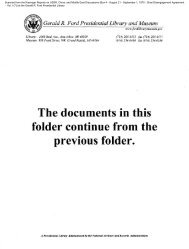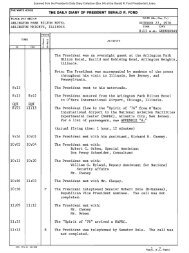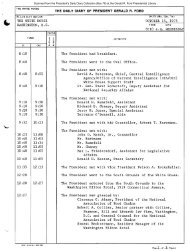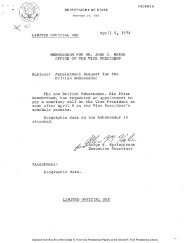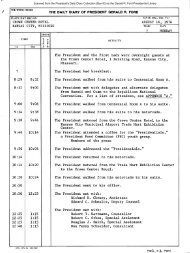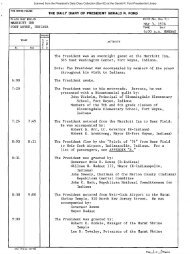October 31, 1975 - Gerald R. Ford Presidential Library and Museum
October 31, 1975 - Gerald R. Ford Presidential Library and Museum
October 31, 1975 - Gerald R. Ford Presidential Library and Museum
You also want an ePaper? Increase the reach of your titles
YUMPU automatically turns print PDFs into web optimized ePapers that Google loves.
future reservoir production operations, protect correlative rights, <strong>and</strong><br />
obtain optimum recovery. Gas h<strong>and</strong>ling facilities will be exp<strong>and</strong>ed <strong>and</strong><br />
the production rate will be doubled. Perhaps over half of the we11s will<br />
be deepened; gas/oiT ratios will be controlled; <strong>and</strong> produced gas wi11 be<br />
reinjected into the gas cap in order to make the gravity drainage mechanism<br />
fully effective.<br />
The consultant firm estimates that total remaining reserves in the principal<br />
reservoir are 1,370 MMBbls. However, 545 MMBbls of these reserves are<br />
believed contingent upon the unitized operations outlined above <strong>and</strong> have<br />
thus been placed in the indicated secondary reserves rather than in the<br />
proved reserves category. The proved ultimate recovery at Yates Grayburg<br />
San Andres is thus indicated to be 34 percent of oil originally in place.<br />
The additional indicated secondary reserves should increase this recovery<br />
efficiency factor to 47 percent. These amounts do not include the escape<br />
oil which was about 2 percent of the oil originally present.<br />
The Yates Field is one of the three oil fields in the United States which<br />
has significant reserve productive capacity. An inability to resolve<br />
equity problems concerning mineral rights, in the past, has prevented the<br />
utilization of this incremental productive capacity. The allowed producing<br />
rate of the field is currently 50,000 barrels daily. Following unitization<br />
of the field toward the end of <strong>1975</strong>, the production rate probably will<br />
be increased to 100,000 barrels daily. The efficiency of the producing<br />
mechanism will be closely observed at this increased rate, particularly<br />
with regard to water <strong>and</strong> gas coning, gas/oil ratio control, <strong>and</strong> the extent<br />
of cont"inued gravity segregation. Then, quite possibly, even higher<br />
production rates will be considered. There is really no question about the<br />
field's ability to produce at a 200,000 barrel daily rate or even more.<br />
The problem now is the inability to determine, in the absence of testing,<br />
just how high the rate can be raised without significant loss in ultimate<br />
recovery.<br />
The FEA report on the Yates Field was prepared by James A. Lewis Engineering,<br />
under Contract No. CO-05-50186-00.<br />
179



